HS Codes, HTS Codes, and Schedule B codes are all related terms in the international trading of goods. However, they all serve a very similar yet very distinct purpose. Often, people are unaware of the purpose of these codes, so they fail to interpret these Codes correctly. This leads to miscalculation of expected duties on the goods being traded.
This blog aims to provide a clear and accurate explanation of these codes and their purpose so that every thought is answered.
Let’s start with the HS Code.
What is the HS Code?
The full form of the HS Code is the Harmonized System Code. By its name, “Harmonization” means to create a system that everyone can agree upon and follow. The HS Code is a 6-digit code that is used to specify/classify/categorize goods being traded internationally. The HS Code is accepted internationally, and it is considered to be a “Standard” for the classification of goods.
Who Founded the HS Code?
We have already established that the HS Code is agreed upon and used worldwide, but who founded it, who maintains this code, and who updates it when required?
The HS Code was founded by the World Customs Organization (WCO) which was set into action on January 1st, 1988. In the early days of the HS Code, it was regarded as the Harmonized System Convention, and its description read: “THE INTERNATIONAL CONVENTION ON THE HARMONIZED COMMODITY DESCRIPTION AND CODING SYSTEM.”

However, ever since the HS Code was launched, multiple changes and explanations have been constantly added to it. By 2017, more than 1500 amendments had been made, and over 2000 decisions had been taken on the HS:

What is the HS Nomenclature?
The HS Nomenclature is a handbook/document containing the HS Code of all the goods that international trade offers. This Nomenclature is updated by WCO every five years. The Nomenclature consists of Chapters, which are further divided into headings, and the headings are further divided into sub-headings.
However, the complete HS Code for the goods is not written. Rather, it is formulated using the number of the chapter the item belongs to, followed by the heading it belongs to, and followed by the subheading (if any)
What is the Structure of the HS Code?
The HS Code is made up of 6-digits in total. However, it is broken down into 3 sections of 2 digits each. These sections are as follows:
- The First Two Digits represent the Chapter of the HS Nomenclature
- The Next Two Digits represent the specific headings of that chapter
- The Last Two Digits represent the sub-headings
Note: The subheadings can have only 1 or no digits, making the HS Code a 4-6 digit code for a particular item.
Let’s look at the structure of an HS Code using the 2017 Nomenclature:

Let’s suppose you are trading “Dried Apples.” The first step is going to locate the chapter which contains fruits. According to the 2017 Nomenclature, It is chapter 8:

Inside Chapter 8, find the heading and the sub-heading that properly defines the item in trade:

Therefore, the HS Code for Dried Apples, According to the 2017 Nomenclature, is going to be 0813.30
What is the General Review Cycle for HS Nomenclature?
Before a new updated version of the HS Nomenclature is presented every 5 years, it has to go through a review cycle. This review cycle is done after 2 years of the current Nomenclature. Depending on that review, amendments are decided by the review committee and implemented in the newer version of the HS Nomenclature.
The current Nomenclature review/update cycle is as follows:

The last review cycle (at the time of this writing) was done in 2019, and the latest HS Nomenclature is the 2022 version, which you can check out by clicking Here!
You now fully understand the HS Code’s purpose, meaning, and structure. Therefore, let’s look at its counterpart, which is the HTS Code.
What is the HTS Code?
HS Code is global, followed by all the members of the WCO. However, different countries require their own set of Codes to imply proper duties and taxes on goods. This is where the HTS Codes come in. But before going deep into what HTS is, we should know what Tariff is.
Each country’s customs organization introduces a Tariff Code, usually based on the HS Code. This is known as that country’s Customs Tariff Code. The tariff code used by the US for import is known as the HTS Code, standing for Harmonized Tariff Schedule Code. The HTS Code uses the HS Nomenclature to form its HTS Nomenclature. The United States International Trade Commission (US-ITC) is responsible for formulating and updating the HTS Nomenclature.
What is the Structure of the HTS Code?
The HTS Code is made up of 10 digits. The first six digits are the HS Code of the item in trade. After the HS Code, the next two digits represent the US Subheading for the item. The last, last two digits are known as Statistical Suffixes. The Statistical Suffix can quantify an item based on its price, its state (quality), or simple quantity. In general, an HTS Code looks like this:

Now that the purpose and the structure of the HTS Code are clear. Let’s take an example.
Example of an HTS Code
Let’s take the code in the above image, “08080.20.25”. When this code is looked up in the HTS Nomenclature, it has the following description:
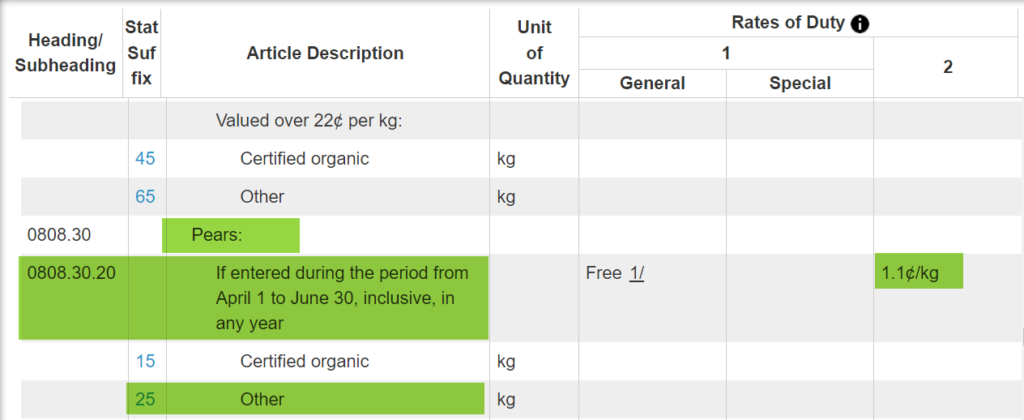
From the image above, you can clearly see that this code is for “Pears,” imported into the United States from April 1 to June 30, which do not fall under the “certified organic” category. The Duty Rate has also been highlighted, which is 1.1 cents per kilogram for this example.
What is the Difference Between HS Code and HTS Code?
The major difference between the two is the purpose and the area of use. The HS Code is used for the general categorization/classification of goods for international trading. It has nothing to do with the fact that the item is being imported or exported. It also doesn’t specify the number of customs/duties to be implied on that item.
On the other hand, the HTS defines the customs and duties to be placed on the items imported into the US.
The World Customs Organization maintains the HS Code, and the US International Trade Commission maintains the HTS Code.
What is Schedule B Number?
Schedule B is a system of codes used by the United States government to track exports, and it is not the same as the HTS code system or the HS code system. Unlike the HTS Code, the Schedule B Code is maintained by the US Census Bureau.
The U.S. Census Bureau uses the Schedule B number to collect trade statistics, and by the U.S. Customs and Border Protection to determine the duties and taxes applicable to a particular product. Foreign customs officials also use it to determine the duties and taxes that will be applied to imported goods.
Structure of the Schedule B Number?
The first six digits of the Schedule B number are based on the international HS code, while the last four digits are unique to the United States. When shipping goods from the United States with a value of over $2,500 or when an export license is used, it is generally required to report the Schedule-B numbers in the Automated Export System (AES).
This code is crucial to receive an Internal Transaction Number (ITN) and must be included in the AESDirect system, which is now part of the Automated Commercial Environment (ACE). The AESDirect system serves to notify the U.S. government that certain commodities are leaving its borders and transmits Electronic Export Information (EEI) details one at a time to comply with export regulations.
How to Find the Schedule B Number of Your Product?
There are two different ways through which you can easily identify the Schedule B number of an item. The first way to head over to the Schedule B Nomenclature:

On this Nomenclature, you can find the chapter that is related to your product, for example. Suppose that you are searching the import Schedule B Code for Oats seeds in Cereals. Then first off, download Chapter 10 – Cereals:

Within Chapter 10, find the headings plus subheading that perfectly defines the Oat seeds for cereals:
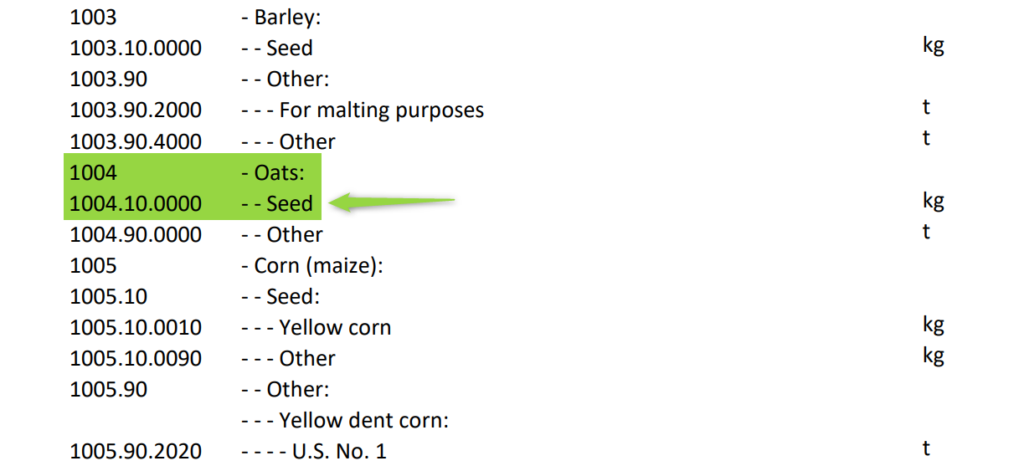
From here, you can clearly see that the Schedule B Number is 1004.10.0000 for Oats Seeds for Cereals.
The other way is by using the official online tool. The US Census Bureau has an online tool, which can be found by clicking Here. This tool is a search engine to search the US Schedule Number of an item.

Let’s try searching the same Oats Seeds for Cereal by typing in Oats Seeds in the search bar:

Choose the characteristics of the selected Item. For our example, we will choose “Seeds”:
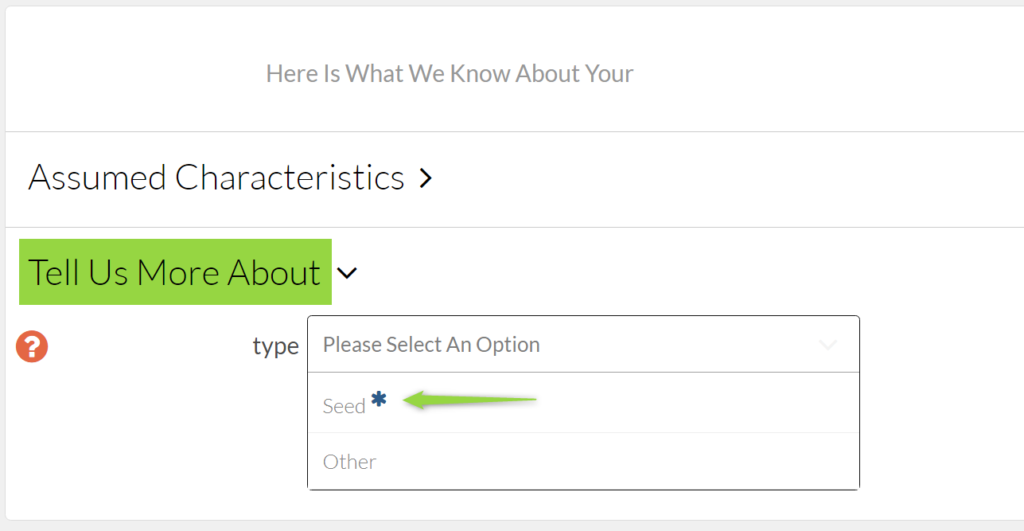
Doing this will show you the chapter number of your item in the Schedule B Nomenclature (1), The Heading Code (2), and the Complete Schedule B Number (3), as shown in the image below:
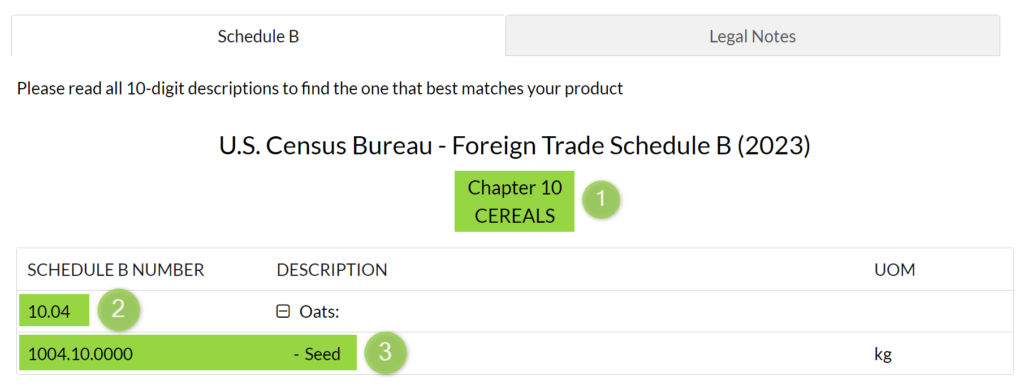
So, using the official online tool, we were able to get the same Schedule B Number, that is, “1004.10.0000”. So, these are the two methods through which you can also find your product’s Schedule B Number.
How to Identify Foreign HS Code?
A lot of people need help identifying the Foreign HS Code. First of all, the HS Code is almost the same for 98% of the world’s countries because it is a standard system. However, if you are looking to find a foreign code, then chances are you are talking about their Tariff Code.
If you are looking to find the Tariff Code, then you can use the Customs Tariff Code Lookup tool by clicking here. However, you will need to have a business email for that.
Apart from this, if you have a 10-digit Schedule B Number or an HTS Code about a product and you want to figure out its international HS Code. Then the first 6 digits represent the HS Code for the product. This holds true for both Schedule B and HTS codes.
In case, the fifth and the sixth digit are zeros. Then it means that the product can be represented by only the chapter number and the heading number. Meaning that only a 4-digit HS Code is sufficient to identify that product.
How to Identify HTS Code and Read Duties?
Identifying a product’s HTS Code and reading the duty is quite an easy task. In fact, we have already done that already in the above section. But this time around, let’s take a procedural approach. For this example, we are going to locate the HTS Code for Certified Organic Flavored Green tea, which comes in immediate packing not greater than 3 Kg.
Step 1: Head over to the HTS Nomenclature by clicking Here!:
Step 2: Choose the Chapter that best defines the category of your product. For our example, it is going to be Chapter 9:

Step 3: In Chapter 9, find the Heading and Subheading that best defines the product’s characteristics:

The heading/subheading so far is “0902.10.10”
Step 4: Next, Locate Further classification (if any):

Combine the heading, subheading, and statistical suffix to find the HTS Code, which in our case is 0902.10.10.15.
Step 5: Calculate Duty by looking at the General Duty Column:
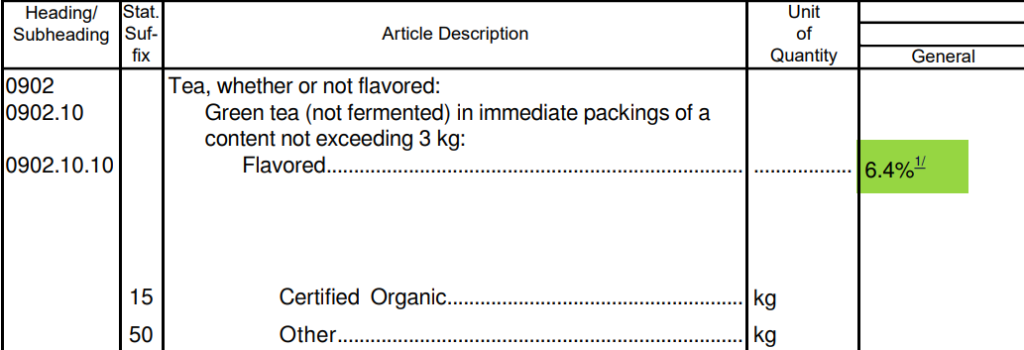
According to this, the customs duty is 6.4% of the original price. However, there are some special duty prices for some countries. These duty rates are written in their own column. Do take into consideration if the import comes from those countries:

So, if the import duty rates change for these countries, that is how you can easily find the HTS Code of a product and calculate its duty.
A Final Overview
We have covered a lot of information that is quite similar to each other. Therefore, before closing this blog, we should take a look at the general overview of all three codes.
| HS Code | HTS Code | Schedule B | |
| Purpose | To classify items in the international trading market. | To identify and correctly imply customs duty on products in the US | To keep track of exports and trends of goods from the US |
| Maintained By | The World Customs Organization (WCO) | United States International Trade Commission (US-ITC) | United States Census Bureau (US-CB) |
| Updates | Updated Every Five Years | Updated Every Year | Updated Every Year |
| Based On | – | Based on HS Code | Based on HTS Code |
| Number of Digits | 6 | 10 | 10 |
Wrap up
Well, that is about all there was to know about the HS Code, the HTS Code, and the Schedule B Number. Hope that everything is clear and every question in your mind has been answered. If there is still something that we have missed, then let us know. We will be more than happy to remove the confusion for you.




